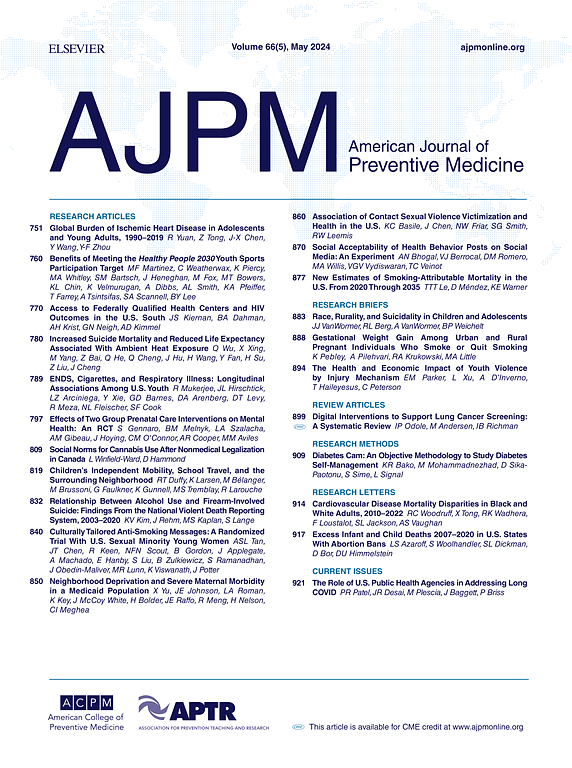The Physical Activity Health Paradox in Type 2 Diabetes
IF 4.3
2区 医学
Q1 MEDICINE, GENERAL & INTERNAL
引用次数: 0
Abstract
Introduction
The physical activity health paradox refers to the contrasting associations of leisure-time physical activity and occupational physical activity with cardiovascular disease, but whether this applies to Type 2 diabetes risk is unknown. This study aimed to investigate the physical activity health paradox and age-specific Type 2 diabetes.
Methods
Working adults (N=5,866) in Denmark aged 30–60 years enrolled in the Inter99 cohort at baseline in 1999 were followed in a Diabetes Register. Incidence rates of Type 2 diabetes as a function of age, sex, and separate and combined levels of self-reported occupational physical activity and leisure-time physical activity were modeled using Poisson regression, adjusting for relevant covariates in separate analyses (2024).
Results
Moderate/vigorous leisure-time physical activity was associated with lower risk of Type 2 diabetes than light (rate ratio=0.63, 95% CI=0.46, 0.85). Strenuous occupational physical activity was associated with a slightly higher risk of Type 2 diabetes than moderate occupational physical activity, but the association diminished adjusted for covariates (rate ratio=1.12, 95% CI=0.79, 1.58). Sedentary leisure-time physical activity combined with any level of occupational physical activity was associated with higher risk of Type 2 diabetes than light leisure-time physical activity/moderate occupational physical activity combined (e.g., sedentary leisure-time physical activity and demanding occupational physical activity) (rate ratio=1.68, 95% CI=1.14, 2.48). Moderate/vigorous leisure-time physical activity combined with any level of occupational physical activity was associated with lower risk of Type 2 diabetes (e.g., moderate/vigorous leisure-time physical activity and moderate occupational physical activity) (rate ratio=0.6, 95% CI=0.39, 0.92).
Conclusions
Leisure-time physical activity lowered the risk of Type 2 diabetes regardless of the level of occupational physical activity, whereas no similar beneficial effects were found for occupational physical activity level. The differential effects of occupational physical activity and leisure-time physical activity on Type 2 diabetes suggest that the paradox may also exist in Type 2 diabetes.
求助全文
约1分钟内获得全文
求助全文
来源期刊

American Journal of Preventive Medicine
医学-公共卫生、环境卫生与职业卫生
CiteScore
8.60
自引率
1.80%
发文量
395
审稿时长
32 days
期刊介绍:
The American Journal of Preventive Medicine is the official journal of the American College of Preventive Medicine and the Association for Prevention Teaching and Research. It publishes articles in the areas of prevention research, teaching, practice and policy. Original research is published on interventions aimed at the prevention of chronic and acute disease and the promotion of individual and community health.
Of particular emphasis are papers that address the primary and secondary prevention of important clinical, behavioral and public health issues such as injury and violence, infectious disease, women''s health, smoking, sedentary behaviors and physical activity, nutrition, diabetes, obesity, and substance use disorders. Papers also address educational initiatives aimed at improving the ability of health professionals to provide effective clinical prevention and public health services. Papers on health services research pertinent to prevention and public health are also published. The journal also publishes official policy statements from the two co-sponsoring organizations, review articles, media reviews, and editorials. Finally, the journal periodically publishes supplements and special theme issues devoted to areas of current interest to the prevention community.
 求助内容:
求助内容: 应助结果提醒方式:
应助结果提醒方式:


